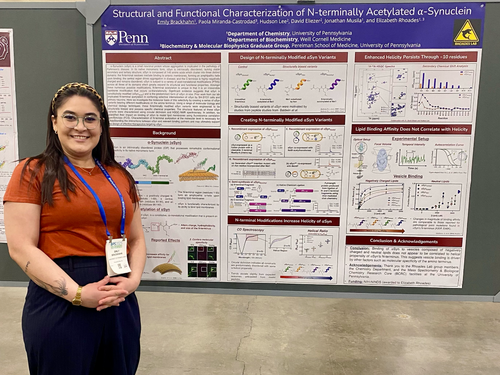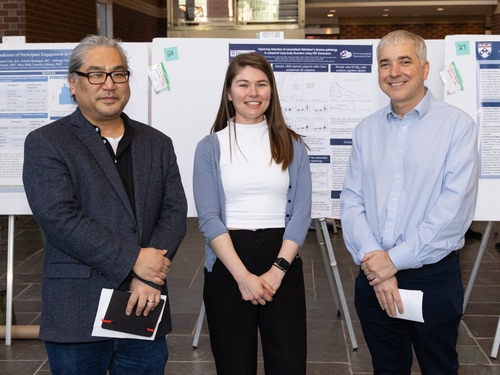Environmental Impacts on Neurodegeneration
As our understanding of neurodegenerative diseases grows, it becomes increasingly clear that the environment can play a significant role in brain health. From air pollution to chemicals in everyday products, environmental factors may be influencing the onset and progression of neurodegenerative conditions like Alzheimer's, Parkinson's, and other forms of dementia. Bringing together leading experts in their fields, the Institute on Aging (IOA) and Penn Center for Excellence in Environmental Toxicology (CEET) tackled this topic co-hosting this year’s Sylvan M. Cohen Annual Retreat and Poster Session.

Read about some of the topics covered below:
"Exposure to environmental toxicants and AD/ADRD risk in CARDIA"
 Recent research has revealed concerning links between exposure to environmental toxicants and the risk of developing Alzheimer's Disease and related dementias. One such study from investigators at the University of Pennsylvania in collaboration with Northwestern University, University of California San Francisco, and Emory University, conducted with data from the Coronary Artery Risk Development in Young Adults (CARDIA) cohort, sheds light on how early environmental exposures can impact brain health later in life.
Recent research has revealed concerning links between exposure to environmental toxicants and the risk of developing Alzheimer's Disease and related dementias. One such study from investigators at the University of Pennsylvania in collaboration with Northwestern University, University of California San Francisco, and Emory University, conducted with data from the Coronary Artery Risk Development in Young Adults (CARDIA) cohort, sheds light on how early environmental exposures can impact brain health later in life.
Aimin Chen, MD, PhD, Professor of Epidemiology at the University of Pennsylvania shared some findings of this study during his lecture at the retreat, exploring how toxicants in our environment such as pesticides and heavy metals might be contributing to the growing burden of neurodegenerative diseases.
Watch Dr. Chen’s full lecture starting at 7:28 here.
"Epigenetics & the Environment: A Biosocial Framework for Understanding Age-Associated Pathology"
 Epigenetics and environmental factors both play a critical role in shaping age-associated pathologies. Research suggest that by adopting a biosocial framework – an approach that combines biological and social factors to understand health and disease -- scientists are now better equipped to understand how genetic predispositions, coupled with environmental influences, contribute to aging-related health outcomes.
Epigenetics and environmental factors both play a critical role in shaping age-associated pathologies. Research suggest that by adopting a biosocial framework – an approach that combines biological and social factors to understand health and disease -- scientists are now better equipped to understand how genetic predispositions, coupled with environmental influences, contribute to aging-related health outcomes.
During his lecture, Corey McMillan, PhD, Associate Professor of Neurology, explored how this integrated approach is helping to unlock new insights into aging, disease prevention, and potential therapeutic strategies. He focused on topics such as social environment, air pollution, and relating epigenetic modifiers to pathology.
Watch Dr. McMillan’s full lecture starting at 29:00 here.
"Wildfire Smoke Exposure and Incident Dementia"
 Holly Elser, MD, PhD, MPH, Neurology Resident at the Hospital of the University of Pennsylvania, has conducted significant research on the potential impacts of wildfire smoke exposure on cognitive health.
Holly Elser, MD, PhD, MPH, Neurology Resident at the Hospital of the University of Pennsylvania, has conducted significant research on the potential impacts of wildfire smoke exposure on cognitive health.
“Motivated by the intensification of wildfires in the US and globally, our study really focuses on the implications of long-term wildfire vs non wildfire PM 2.5 exposure for dementia among Southern Californians,” she explained. PM 2.5 refers to fine particulate matter that is 2.5 micrometers or smaller in diameter – small enough to be inhaled deeply into the lungs and potentially enter the bloodstream – and is a major component of air pollution generated by a variety of sources, including wildfires, vehicle emissions, industrial processes, and burning of fossil fuels. Results showed that while long-term exposure to both wildfire and non-wildfire PM 2.5 is associated with dementia, there was a stronger magnitude-of-association observed for wildfire PM 2.5. Additionally, the risk was more pronounced among some subgroups and among those in high-poverty census tracts.
Watch Dr. Elser’s full lecture starting at 52:17 here.
"Immune Signals and Brain Health: How Environmental Stimuli Shape the CNS"
 Certain external factors, such as infections, pollutants, and stressors, can trigger immune responses that affect brain function and contribute to neurological disorders. Yeong Shin Yim, PhD, Assistant Professor of Pharmacology, University of Pennsylvania, and her team explore this connection between immune signals and brain health focusing on how environmental stimuli can influence the central nervous system (CNS). Understanding how certain environmental exposures can alter immune signaling pathways and potentially lead to neuroinflammation and conditions like neurodegenerative diseases may offer insight into potential pathways for developing treatments for various CNS-related disorders.
Certain external factors, such as infections, pollutants, and stressors, can trigger immune responses that affect brain function and contribute to neurological disorders. Yeong Shin Yim, PhD, Assistant Professor of Pharmacology, University of Pennsylvania, and her team explore this connection between immune signals and brain health focusing on how environmental stimuli can influence the central nervous system (CNS). Understanding how certain environmental exposures can alter immune signaling pathways and potentially lead to neuroinflammation and conditions like neurodegenerative diseases may offer insight into potential pathways for developing treatments for various CNS-related disorders.
Watch Dr. Yim’s full lecture starting at 1:04:49 here.
"Factoring Sleep Disruption into the Neural Exposome"
 Sigrid Veasey, MD, Professor of Medicine, University of Pennsylvania, examines how disruptions in sleep, whether caused by environmental factors, lifestyle, or health conditions, can contribute to neurodegenerative diseases and cognitive decline. Her work explores the complex interactions between sleep patterns, immune responses, and neural health, emphasizing how poor sleep can exacerbate the brain's vulnerability to external environmental stressors. By integrating sleep disruption into the broader framework of the neural exposome, Veasey’s research aims to highlight the critical role of sleep in maintaining brain health and offer new insights into potential therapeutic targets for improving sleep and preventing neurodegenerative diseases.
Sigrid Veasey, MD, Professor of Medicine, University of Pennsylvania, examines how disruptions in sleep, whether caused by environmental factors, lifestyle, or health conditions, can contribute to neurodegenerative diseases and cognitive decline. Her work explores the complex interactions between sleep patterns, immune responses, and neural health, emphasizing how poor sleep can exacerbate the brain's vulnerability to external environmental stressors. By integrating sleep disruption into the broader framework of the neural exposome, Veasey’s research aims to highlight the critical role of sleep in maintaining brain health and offer new insights into potential therapeutic targets for improving sleep and preventing neurodegenerative diseases.
Watch Dr. Veasey’s full lecture starting at 1:29:20 here.
"Using exposomics to study neurodegeneration"
 Exposomics is the comprehensive study of the totality of environmental exposures an individual experiences over their lifetime, including pollutants, chemicals, diet, and lifestyle. Gary Miller, PhD, Professor of Environmental Health Sciences, Columbia University, focuses his research on how these exposures interact with genetic and biological factors to influence the development and progression of neurodegenerative diseases, such as Alzheimer’s and Parkinson’s. Quoting his study on the topic, Dr. Miller explains that “for these external forces to have an effect on health, they must alter our biology.” By using exposomics, Dr. Miller aims to identify specific environmental triggers that contribute to cognitive decline and neuroinflammation, helping to uncover new targets for prevention, diagnosis, and treatment. Miller’s work emphasizes the importance of considering the complex and cumulative effects of environmental exposures in understanding brain health.
Exposomics is the comprehensive study of the totality of environmental exposures an individual experiences over their lifetime, including pollutants, chemicals, diet, and lifestyle. Gary Miller, PhD, Professor of Environmental Health Sciences, Columbia University, focuses his research on how these exposures interact with genetic and biological factors to influence the development and progression of neurodegenerative diseases, such as Alzheimer’s and Parkinson’s. Quoting his study on the topic, Dr. Miller explains that “for these external forces to have an effect on health, they must alter our biology.” By using exposomics, Dr. Miller aims to identify specific environmental triggers that contribute to cognitive decline and neuroinflammation, helping to uncover new targets for prevention, diagnosis, and treatment. Miller’s work emphasizes the importance of considering the complex and cumulative effects of environmental exposures in understanding brain health.
Watch Dr. Miller’s full lecture starting at 1:54:37 here.
Meet our Poster Session Winners
BASIC SCIENCE

Structural and Functional Characterization of N-terminally Acetylated Alpha Synuclein
Presented by: Emily Brackhahn
Authors: Emily Brackhahn, Paola Miranda-Castrodad, Hudson Lee, David Eliezer, PhD, and Elizabeth Rhoades, PhD
Q: Can you briefly summarize the main objective of your research?
A: My thesis work focuses on uncovering how N-terminal acetylation impacts the structure and function of αSyn which is critical for understanding the mechanisms underlying the physiological interactions of this enigmatic protein.
Q: What are the key findings of your research?
A: Binding of αSyn to vesicles composed of negatively charged and neutral lipids does not appear to be correlated to the α-helical propensity of αSyn’s N-terminus. This suggests vesicle binding is driven by other factors such as molecular specificity of the amino terminus.
Q: What is the significance of your research in real-world applications?
A: Studies that illuminate the molecular basis of αSyn’s physiological interactions have major implications for treating neurodegenerative disease and will ultimately validate the identification of appropriate molecular targets for diagnostic and therapeutic design.
Q: What are the next steps or potential directions for future research based on your findings?
A: N-terminal acetylation is functional modification of αSyn. In future work, we are interested in studying the combinatorial effects of N-terminal acetylation and other known pathological post-translational modifications such as phosphorylation on αSyn’s structure and function.
Q: Is there any aspect of your research that might surprise people or challenge existing assumptions?
A: N-terminal acetylation is a modification that is often overlooked in biochemical and biophysics studies involving αSyn, despite abundant evidence that αSyn is N-terminally acetylated in both health and in disease. My research suggests there are both chemical and structural properties of N-terminal acetylation that influence αSyn’s interactions with native cellular partners and thus is a necessary modification that must be considered when studying this protein.
CLINICAL RESEARCH, EDUCATION, OR OTHER

Neuropsychological dysfunction differentially relates to desegregation of brain networks in behavioral variant frontotemporal dementia
Presented by: Melanie A. Matyi
Authors: Melanie A. Matyi, Hamsanandini Radhakrishnan, Jeffrey S. Phillips, Philip A. Cook, Emma Rhodes, James C. Gee, David J. Irwin, Corey T. McMillan & Lauren Massimo
Q: Can you briefly summarize the main objective of your research?
A: The brain is organized into intrinsic networks. In healthy brains, segregation of brain networks facilitates functional specialization of cognition. However, network structure breaks down in neurodegenerative diseases. Limited evidence exists evaluating the role of network desegregation in behavioral variant frontotemporal degeneration (bvFTD), especially the breakdown of structural networks and the impact of this process on cognition. Therefore, the goals of my research were to first test if structural network breakdown is present in bvFTD and then to assess the impact of structural network breakdown on a core clinical feature of bvFTD, executive dysfunction.
Q: What are the key findings of your research?
A: I found that patients with bvFTD, compared to cognitively normal control participants, exhibited desegregation of the salience network and that the extent to which the salience network was desegregated was associated with worse executive function. Importantly, greater network desegregation was related to executive dysfunction independent of overall disease burden, measured by cortical thinning.
Q: What is the significance of your research in real-world applications?
A: My findings indicate that brain network desegregation, reflecting reduced neural capacity for specialized processing, may contribute to the emergence of executive dysfunction in bvFTD.
Q: What are the next steps or potential directions for future research based on your findings?
A: It is possible that network desegregation is a mediator of executive dysfunction in bvFTD. Future work can examine these constructs longitudinally to assess if network desegregation precedes the emergence of executive dysfunction in bvFTD. Additionally, these findings indicate that network desegregation is a unique contributor to clinical features of bvFTD. Therefore, future work should identify mechanisms of network desegregation as such underlying processes (e.g., neurotransmitter systems, gene expression, cell types) could inform efforts to manage executive dysfunction in bvFTD.

